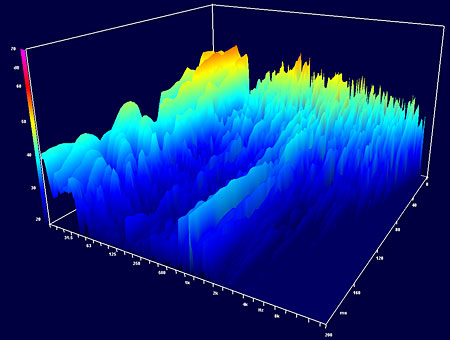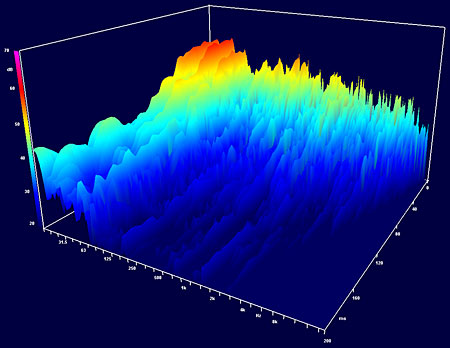| Columns Retired Columns & Blogs |
Music in the Round #39 Page 2
The AV888 menu system is decidedly different in navigation from those of the Denon and Integra preamp-processors but relatively easy to manage: all page titles are listed in the left panel of the Arcam's display, the current page occupies the large window, and help texts are displayed below as you scroll from option to option. Setting up each input is independent and logical, and in most ways the AV888 is far more flexible than the Integra DTC-9.8 or Cary Cinema 11 pre-pros. An exception is that there is only one choice of bass-management crossover frequency for all speakers designated as Small. Interestingly, the AV888 lets you associate your choice of video source with any of the non-HDMI audio inputs. This allowed me to hear the multichannel audio input and display the video menus from the Oppo. I could also listen to a music source while watching a pre-season football game!
The AV888's automatic setup system uses a supplied microphone that looks the same as the one that accompanied the Cary Cinema 11, and I anticipated similar disappointment. But however clumsy that mike is, Arcam offers useful positioning information, and I was able to set up the AV888 quickly and accurately by taping the mike to a tripod placed at the primary listening position. Arcam damns with faint praise its own room EQ by defaulting to "EQ = Off" and requiring the user to activate it for each source. (A nontechnical discussion of the EQ system can be downloaded from Analog Devices here.) The effect of the EQ was to greatly increase the clarity and definition of the front soundstage and remove some influence of room modes in the upper bass and midrange, where it is most noticeable. Audibly, and confirmed by measurements taken with XTZ's Room Analyzer (see below), the Arcam's room EQ smoothed the low bass but had little effect on its decay time. The tradeoff was that there was a significant enhancement of "presence," making the EQ'd mode seem even louder than otherwise, due to a measured 4dB increase in the mode's level across the audioband. I ended up preferring the EQ left on, although this often presented a difficult choice. Arcam's EQ is not the equal of Audyssey or Anthem Room Correction, but it's effective and useful.
Some annoying technical problems ended up being easily resolved. First, the provided remote control was defective, but Arcam had a new one in my hand within two days. Second, the remote has some quirky features to which I never entirely adapted. For example, its labeled buttons, which Arcam calls Device Mode/Source Keys, not only select the input source, but also, annoyingly, switch the remote into the control mode for that device. Thus, you can't repeatedly press DVD and AV to A/B those two sources without putting the control back into Amp mode. There are direct-access buttons, but they're numbered, not labeled. I accept the logic for this, and most users will probably adapt to it—or get a separate universal remote, such as the Harmony. Finally, although the Oppo BDP-83 and the Arcam each worked fine with other partners, they at first failed to communicate with each other. I had to set the Oppo for RGB video (rather than auto or YCbCr) to get a useful display, and even then, there was no audio from HDMI. Cries for help to Oppo and Arcam resulted in swift action: installing new firmware (v1.9) in the AV888 was the cure.
The Arcam sounded as good as or better than other similar products I have used: It was a pleasure to listen to stereo or multichannel music from the Oppo or the Denon through the AV888. The front of the soundstage had a wider wrap than with the Integra, and while I can't fault either for its revelation of detail, the Arcam was notably smoother and sweeter in the treble. I was particularly impressed with the 24/192 two-channel recordings on DVD from Acousence. Although Jonathan Darlington and the Duisberg Philharmonic's performances of Mahler's Symphony 6 (ACO-CD 21008) and Shostakovich's Symphony 15 (ACO-CD 20607) are somewhat more than competent, the recordings themselves are formidable, and the AV888 let me hear their remarkable depth, detail, and weight. (Free sample downloads and full recordings are available here.) Overall, the Arcam's bass extension was excellent, though the midbass depended on whether one was using the room EQ, which tended to warm things up a bit more than was necessary. For home theater, that was all to the good; it somewhat colored voices and instruments in music-only recordings, but was relatively innocuous.
I did most of my listening via HDMI for reasons of convenience, but the AV888's digital and analog inputs were excellent. S/PDIF sources sounded as good as they might via a modern external DAC, and multichannel analog was remarkably clear, dynamic, and open. The AV888 does not digitize this input, and so cannot apply room EQ or speaker delays to it, but it does apply channel-level adjustments. Inevitably, the sound will be different from that obtained from HDMI, but A/B comparisons with the Oppo BDP-83 were surprising. Comparing analog multichannel with room-EQ'd HDMI, I marginally preferred the latter for its presence, warmth, and breadth of soundstage. Comparing analog multichannel with HDMI sans room EQ turned the tables: analog now offered a livelier, more vivid frontal presentation of the performers, albeit at the expense of seamless surround to the sides and back. Indeed, the Arcam had the best analog-bypass sound I have yet heard from a pre-pro. I felt that, in any mode, the AV888 provided a richer, more immersive audio experience than my Integra DTC-9.8; via the analog input, it was simply no contest.
As for the latest bells and whistles, the AV888 handled dts-HD MA and Dolby TrueHD with aplomb for both music and movies, giving me many hours of complete satisfaction. I also used both the RJ45 and USB inputs, connecting the former to my home network via powerline links, and the latter to flash drives loaded with WAV and FLAC files. In either latter case, the AV888 can't handle sample rates greater than 96kHz, but Arcam is looking into that limitation. But for both inputs, the AV888 has a well-integrated onscreen menu and selection system. That the sound quality was limited only by the source component was apparent: streaming audio and standard 16/44.1 via USB or from my PC were as good as popping the original CD into a hardwire-connected disc player.
Quirks and growing pains aside, the Arcam AV888 offers outstandingly good sound in every mode, and remarkably so with analog sources. Couple this with up-to-the-moment capabilities such as decoding of HD audio, network capabilities, an easy-to-use auto-setup routine, and room EQ—as well as excellent video—and the AV888 is highly recommended.
XTZ Room Analyzer with v2 software
A brief note about this handy-dandy tool that I wrote about in November 2008: To what has become my favorite device for efficiently monitoring room responses and quickly checking my ears, XTZ has added two new functions. First, in the standard mode, which shows windows for frequency response and spectral decay below 200Hz, you can now overlay the results of up to four frequency-response measurements—extremely useful for comparison purposes. Second, an entirely new operation mode takes FR and spectral-decay measurements from 20Hz to 20kHz. This lacks the resolution of the standard 20–200Hz mode, and it's limited to a single signal sweep from a single mike position, but it, too, lets you overlay up to four separate sweeps. Moreover, its three-dimensional, multicolored display of time, magnitude, and frequency shows more of the total performance of your system and room. I used this to see just how effective the Arcam AV888's room EQ was at smoothing the frequency response in the midrange (150Hz–1kHz) and reducing RT60 (reverberation time), and how it was less effective below 150Hz—see figs.1 & 2.

Fig.1, In-room response without equalization, XTZ plot.

Fig.2, In-room response with equalization by Arcam AV888, XTZ plot.
The Room Analyzer is a good toolkit now made better, and the pattern of improvement and enhancement established by XTZ suggests that it will grow even more powerful in the future. Recommended . . . again.
Addendum: Sony exonerated!
Before returning the AV888 to Arcam, I hooked it up to Sony's SCD-XA5400ES SACD/CD player in my Connecticut system (see my review of the Sony in the May 2009 Stereophile). I wanted to take another stab at confirming my conclusion, reached after a trial at a local audio shop of the Sony with an early Classé SSP-800 preamplifier-processor, that the Sony wouldn't output PCM via HDMI from SACDs (see "Music in the Round," July 2009). Sony's PR agency insisted that the SCD-XA5400ES would output PCM via HDMI, but there's no mention of it in Sony's documents, and no user control of the HDMI data format. With the Classé SSP-800, DSD tracks were silent; only "Red Book" CD datastreams worked via HDMI.

But, lo and behold, the Arcam AV888's display read "Digital PCM 5.1" when I selected the Sony while playing SACDs, and music blossomed forth from all channels with every SACD I tried, whether 5.1-, 5.0-, 4.0-, or 2.0-channel. Arcam's Nick Clarke confirmed that his company is very persnickety about EDID, the handshaking protocol by which HDMI-linked products communicate, and that the AV888 won't accept a DSD signal—so I must have been hearing PCM signals. Apparently, that early Classé pre-pro was sending the Sony the wrong message. I took the Sony back to my Manhattan apartment, where I hooked it up to my Meridian HD621/861, with similar success.
I wonder if anyone else has tried to see if the Sony would output PCM via HDMI from SACDs with any linked components, as no one has challenged my published statements that it wouldn't. I apologize to anyone who may have accepted those statements at face value, and to Sony for my having misrepresented their excellent SCD-XA5400ES SACD/CD, which indeed does output PCM and DSD via HDMI.
- Log in or register to post comments




































